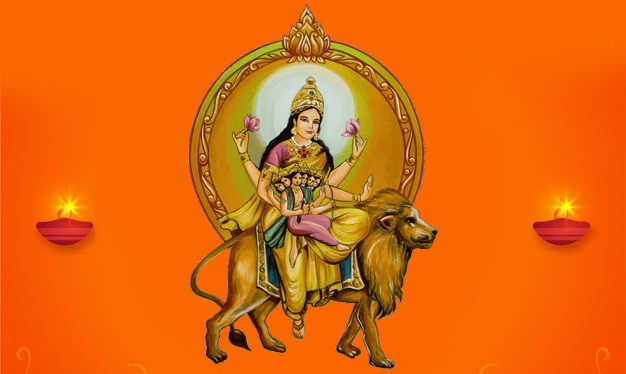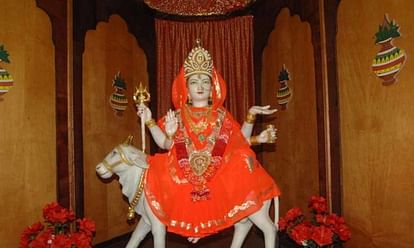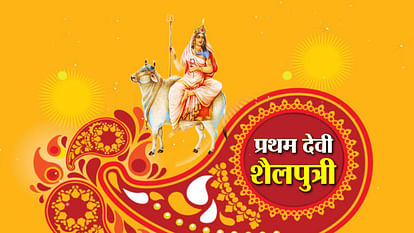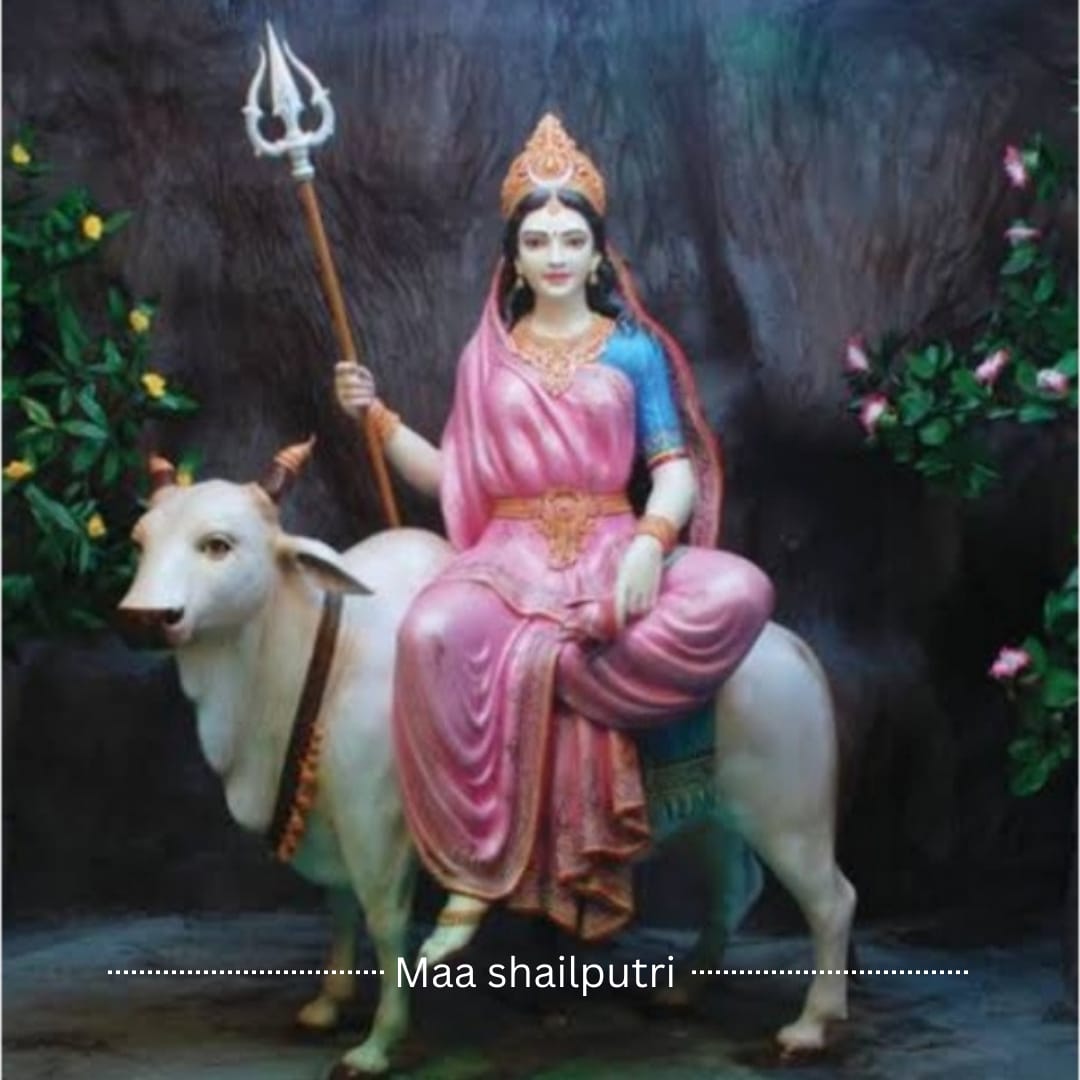Skandamata is a Hindu goddess who is worshipped on the fifth day of Navratri, a nine-day Hindu festival that celebrates the triumph of good over evil. Skandamata is the mother of Skanda or Kartikeya, the Hindu god of war, and is a form of Goddess Durga.
Skandamata is depicted as a four-armed goddess, holding a lotus flower and a bell in her upper hands, while her lower hands are in the Abhaya Mudra (gesture of fearlessness) and the Varada Mudra (gesture of granting boons). She rides on a lion, which represents power and courage. and her complexion is golden, signifying prosperity.

According to Hindu mythology, Skandamata was born to Lord Vishnu as his daughter in the form of Shakti. She married Lord Shiva and gave birth to Lord Skanda. Skandamata is considered to be a benevolent and compassionate goddess who blesses her devotees with courage, strength, and success. She is also known for her maternal love and protection.
Worshipping Skandamata during Navratri is believed to bring peace, prosperity, and happiness to one's life. Devotees offer her flowers, fruits, sweets, and other offerings to seek her blessings. Reciting Skandamata's mantra, "Om Devi Skandamatayai Namah," is also considered auspicious and helps in attaining spiritual and material benefits.
Skandamata is a symbol of motherhood and represents the divine feminine energy in Hinduism. She reminds us of the importance of maternal love and protection in our lives. By worshipping Skandamata, we can connect with our inner strength and overcome our fears and obstacles.
Skandamata is considered a very powerful goddess, and her worship is believed to bring peace, prosperity, and happiness to her devotees. It is said that worshipping Skandamata on the fifth day of Navratri can help overcome all kinds of difficulties and obstacles in life.
To perform Skandamata puja, devotees usually clean their homes and decorate their puja rooms with flowers and rangolis. They offer lotus flowers, fruits, and sweets to the goddess and chant mantras and hymns in her praise.
Skandamata is also associated with the Svadhisthana chakra, which is located at the base of the spine and is associated with emotions, creativity, and sensuality. It is believed that meditating on Skandamata and focusing on this chakra can help balance emotions and improve creativity.
In addition to her role as a mother and protector, Skandamata is also believed to have the power to destroy negative energy and protect her devotees from harm. It is said that worshipping her with devotion and faith can help them overcome all kinds of obstacles and lead to success in all areas of life.
The significance of Skandamata can be traced back to ancient Hindu texts such as the Devi Mahatmya, which describes the various forms of the goddess Durga. Skandamata is also mentioned in the Skanda Purana, which is dedicated to Lord Kartikeya.
In conclusion, Skandamata is an important deity in Hindu mythology and is worshipped with great devotion and reverence during the Navratri festival. She is a symbol of motherhood and represents the power of love, compassion, and protection. By worshipping Skandamata, we can gain her blessings and guidance in our lives.
Mother Shailputri, also known as Goddess Shailputri, is the first among the nine forms of Goddess Durga. She is worshiped on the first day of the Navratri festival, which is celebrated all across India with great enthusiasm and devotion. The word ‘Shailputri’ is derived from two words, ‘Shail’ meaning mountain, and ‘Putri’ meaning daughter. Thus, she is known as the daughter of the mountains.
According to Hindu mythology, Mother Shailputri is believed to be the reincarnation of Sati, the first wife of Lord Shiva. Sati had immolated herself in the holy fire as she could not bear the humiliation meted out to her husband by her own father, King Daksha. After Sati's death, Lord Shiva became detached from the world, and his anger manifested in the form of Veerabhadra, who destroyed King Daksha's yajna.
To pacify Lord Shiva, the Gods created a new body for Sati, which was found in the Himalayan mountains. This new form was named Shailputri, and she married Lord Shiva. She is depicted as a beautiful woman riding on a bull, with a trident in her right hand and a lotus flower in her left hand. The bull is believed to be her vehicle, which represents dharma, strength, and stability.

Mother Shailputri is also associated with the Muladhara chakra, which is located at the base of the spine. This chakra is associated with the element of earth, and it represents stability, grounding, and the physical body. It is believed that by worshiping Mother Shailputri, one can activate and balance the Muladhara chakra, which can bring stability and balance to one's life.
During Navratri, devotees worship Mother Shailputri with great devotion and offer her flowers, fruits, and sweets. They also perform various rituals, such as fasting and reciting mantras, to seek her blessings. It is believed that by worshiping her, one can overcome all obstacles and attain success in life.
Her worship during Navratri is believed to bring peace, prosperity, and happiness to the devotees. On the first day of Navratri, devotees offer special prayers and perform puja to seek the blessings of Maa Shailputri. It is also believed that worshipping Maa Shailputri can help in overcoming physical and mental ailments, and provide strength and courage to face life's challenges.

Apart from Navratri, Maa Shailputri is also worshipped on various occasions, such as weddings, childbirth, and housewarming ceremonies. She is considered to be the nurturer of the universe and the provider of abundance and blessings.
In conclusion, Maa Shailputri is an embodiment of strength, beauty, and divine power. Her worship helps us connect with nature and seek the blessings of the divine feminine. Her grace can help us overcome obstacles and lead a life filled with peace and prosperity.

For 10 seasons, from 1994 to 2004, the television landscape was forever changed by a show that depicted the trials, triumphs, and hilarious adventures of a tight-knit group of friends living in New York City. "Friends" became a cultural phenomenon, capturing the hearts of millions of viewers around the world. With its brilliant writing, talented ensemble cast, and relatable characters, it created unbreakable bonds both on-screen and off. In this blog post, we will dive deep into the enduring legacy of the legendary "Friends" series, exploring the reasons behind its massive success and the impact it has had on popular culture.

The Birth of a Sitcom Sensation :
"Friends" was the brainchild of David Crane and Marta Kauffman, who conceived a show centered around a group of young friends navigating the ups and downs of life in the bustling city of New York. The series premiered on September 22, 1994, and quickly captured the attention of audiences with its sharp writing, witty humor, and relatable storylines. From the iconic Central Perk coffee shop to the unforgettable theme song, the show had all the ingredients to become an instant hit.
Endearing Characters and Stellar Cast :
One of the primary reasons behind the series' success was its ensemble cast. Jennifer Aniston, Courtney Cox, Lisa Kudrow, Matt LeBlanc, Matthew Perry, and David Schwimmer portrayed the beloved characters of Rachel, Monica, Phoebe, Joey, Chandler, and Ross, respectively. Their remarkable chemistry and impeccable comedic timing brought the characters to life, making them feel like real friends to the viewers.
Each character had their unique quirks and personalities, allowing the audience to find someone to relate to. Whether it was Rachel's fashion sense, Monica's perfectionism, Phoebe's eccentricity, Joey's lovable charm, Chandler's sarcasm, or Ross's nerdy charm, there was a friend for everyone. These characters faced relatable challenges such as career struggles, relationship woes, and the complexities of adulting, which endeared them even more to the audience.
Memorable Moments and Enduring Catchphrases :
"Friends" delivered numerous unforgettable moments that have become embedded in pop culture history. From Ross's iconic "We were on a break!" to Joey's "How you doing'?" pick-up line, the series introduced a plethora of catchphrases that have since become ingrained in our everyday conversations. Whether it's "The Routine" dance, the Holiday Armadillo, or Joey's inability to share food, these moments continue to resonate with fans, even years after the show's finale.
Additionally, "Friends" showcased some of the most heartwarming and emotionally charged scenes. From Monica and Chandler's wedding to Ross's pivot disaster, the show masterfully balanced humor with touching moments that tugged at our heartstrings. It was this ability to elicit laughter and tears that made "Friends" such a beloved series.
Cultural Impact and Enduring Legacy :
The influence of "Friends" extends far beyond its initial run. It has had a profound impact on popular culture, inspiring countless other sitcoms and paving the way for ensemble casts. The show's success also propelled its cast members to new heights of stardom, with many of them becoming household names and enjoying successful careers beyond the series.
Even today, "Friends" continues to resonate with new generations through its availability on streaming platforms. The show's timeless themes of friendship, love, and the pursuit of happiness are universal and relatable, allowing it to maintain its relevance in an ever-changing television landscape.
Conclusion :
The legendary "Friends" series created unbreakable bonds not only between its characters but also with its audience. It remains an iconic sitcom that has stood the test of time, bringing laughter, joy, and a sense of familiarity to millions of viewers worldwide. The show's enduring legacy is a testament to its exceptional writing, stellar cast, and relatable storytelling. As we rewatch the episodes or introduce "Friends" to new fans, the series will continue to remind us of the importance of true friendship and the power of laughter.

Skandamata is a Hindu goddess who is worshipped on the fifth day of Navratri, a nine-day Hindu festival that celebrates the triumph of good over evil. Skandamata is the mother of Skanda or Kartikeya, the Hindu god of war, and is a form of Goddess Durga.
Skandamata is depicted as a four-armed goddess, holding a lotus flower and a bell in her upper hands, while her lower hands are in the Abhaya Mudra (gesture of fearlessness) and the Varada Mudra (gesture of granting boons). She rides on a lion, which represents power and courage. and her complexion is golden, signifying prosperity.

According to Hindu mythology, Skandamata was born to Lord Vishnu as his daughter in the form of Shakti. She married Lord Shiva and gave birth to Lord Skanda. Skandamata is considered to be a benevolent and compassionate goddess who blesses her devotees with courage, strength, and success. She is also known for her maternal love and protection.
Worshipping Skandamata during Navratri is believed to bring peace, prosperity, and happiness to one's life. Devotees offer her flowers, fruits, sweets, and other offerings to seek her blessings. Reciting Skandamata's mantra, "Om Devi Skandamatayai Namah," is also considered auspicious and helps in attaining spiritual and material benefits.
Skandamata is a symbol of motherhood and represents the divine feminine energy in Hinduism. She reminds us of the importance of maternal love and protection in our lives. By worshipping Skandamata, we can connect with our inner strength and overcome our fears and obstacles.
Skandamata is considered a very powerful goddess, and her worship is believed to bring peace, prosperity, and happiness to her devotees. It is said that worshipping Skandamata on the fifth day of Navratri can help overcome all kinds of difficulties and obstacles in life.
To perform Skandamata puja, devotees usually clean their homes and decorate their puja rooms with flowers and rangolis. They offer lotus flowers, fruits, and sweets to the goddess and chant mantras and hymns in her praise.
Skandamata is also associated with the Svadhisthana chakra, which is located at the base of the spine and is associated with emotions, creativity, and sensuality. It is believed that meditating on Skandamata and focusing on this chakra can help balance emotions and improve creativity.
In addition to her role as a mother and protector, Skandamata is also believed to have the power to destroy negative energy and protect her devotees from harm. It is said that worshipping her with devotion and faith can help them overcome all kinds of obstacles and lead to success in all areas of life.
The significance of Skandamata can be traced back to ancient Hindu texts such as the Devi Mahatmya, which describes the various forms of the goddess Durga. Skandamata is also mentioned in the Skanda Purana, which is dedicated to Lord Kartikeya.
In conclusion, Skandamata is an important deity in Hindu mythology and is worshipped with great devotion and reverence during the Navratri festival. She is a symbol of motherhood and represents the power of love, compassion, and protection. By worshipping Skandamata, we can gain her blessings and guidance in our lives.




